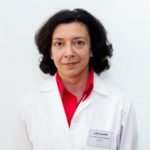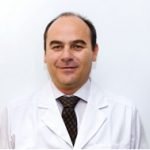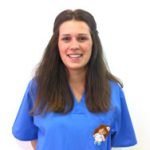Contents
1.
2.
3.
3.1.
3.2.
4.
4.1.
4.2.
4.3.
4.4.
5.
6.
7.
Contact information
Description
The Reprofiv Clinic is a private center dedicated to helping couples who wish to become parents but have difficulty doing so. The clinic has a multidisciplinary team of 14 professionals.
Furthermore, Reprofiv is accredited and approved by the Ministry of Health of the Autonomous Community of Madrid and by the Ministry of Health. In addition, the in vitro fertilization laboratory is jointly accredited by the Spanish Association for the Study of the Biology of Reproduction (ASEBIR) and ESHRE, the European Society for Human Reproduction.
Finally, it should be noted that Reprofiv has a foundation dedicated to research, teaching, and social action.
If you need information on how to get to the clinic, either by public or private transport, you can access this link.
Facilities & Services
According to the images published on the Reprofiv website, the waiting room and reception area are together, consisting of a counter, green sofas, and a small table with magazines. The offices have examination rooms with a gynecological stretcher, an ultrasound machine, and a screen so that the woman can observe the procedure. This clinic also has a laboratory and operating room.
Also, Reprofiv offers its patients a psychological support service during the entire treatment, since it can lead to a stressful situation that could alter the results. In this way, the negative influence of feelings is diminished.
On the other hand, this clinic also indicates that it has the possibility of financing treatments tailored to each patient.
However, all this information could not be verified by the inviTRA specialists.
The fertility treatments that can be carried out in Reprofiv are specified in the following table.
Embryo cryopreservation
Frozen Embryo Transfer
In Vitro Fertilization / ICSI
IUI with Donor Sperm
IUI with Partner's Sperm
IVF with Donor Egg & Donor Sperm
IVF with Donor Eggs
IVF with Donor Sperm
Preimplantation Genetic Diagnosis
Reciprocal IVF
If you're still unsure which fertility treatment is right for you and would like to know more about it, we suggest you read on here: Fertility Treatment Overview.
The treatment costs may vary significantly depending on the tests or techniques included or not, such as the seminogram, medication, fertility testing, medical visits, prolonged culture or embryo vitrification.
This Tool helps you to find out the exact costs of the different fertility clinics (what's included and what's not) and provides you with lots of useful tips for your first appointment.
Complementary techniques
In addition to all the treatments indicated in the previous section, Reprofiv has the technology and professionals necessary to carry out the following complementary techniques, in order to increase the possibilities of treatment success:
Diagnostic Tests
The diagnostic tests that can be performed at Reprofiv before determining the appropriate fertility treatment are as follows:
- Female fertility study.
- Male fertility study.
- Semen analysis.
- Gynecological revision.
- 3D and 4D ultrasound.
- Non-invasive prenatal diagnostic test.
Success rates
The Spanish Fertility Society is in charge of compiling the results of all the Spanish assisted reproduction clinics every year and making a statistical analysis. In fact, the SEF is the only scientific and independent organization of the clinics that collects and publishes these data in an objective manner.
Although our analysis of this clinic was carried out in 2nd November, 2020, we have to indicate that the last report published by the SEF shows the success rates obtained in the year 2018 (National Activity Register 2018-SEF Register).
Normally, there is a delay of about 2 years in the publication of these statistics due to the difficulty in data collection and the controls that are carried out. It should be noted that, to collect data from a gestation achieved in December 2017, we must wait until delivery, which will be approximately in September 2018.
It should also be taken into account that directly comparing pregnancy rates between different clinics can lead to misunderstandings because there are many factors that influence the results, such as the cause of sterility or the particular characteristics of each treatment.
Therefore, the SEF data shown below should be taken as a mere guide. In addition, we recommend reading this article for a better interpretation of the statistics.
More information
IVF/ICSI
Realized cycles
Number of total cycles performed by the clinic in a year.
The SEF does not provide an exact number of annual cycles that each center performs, but rather it does so in the form of ranges as follows: less than 100 annual cycles, between 100 and 500 annual cycles, or more than 500 annual cycles.
From inviTRA we consider that for a better interpretation of the results it would be good that the SEF provides more exact data or smaller ranges for the number of annual cycles.
This is the total number of cycles performed by Reprofiv in a year.
More information
Cycles with fresh embryos: 0 a 99 per year
Cycles with frozen embryos: 100 a 500 per year
Implantation rate per transfer
The probability that an embryo will implant in the woman's uterus after the transfer.
This success rate refers to the probability that a transferred embryo will nest in the woman's uterus. It is calculated as follows: number of gestational sacs observed on ultrasound divided by the number of embryos transferred.
The SEF shows this value in the form of an interval, since it is very complicated to provide an exact percentage due to the variability of factors that we have already discussed.
It should also be taken into account that the more assisted reproduction cycles the clinic performs, the narrower this interval will be and the better the interpretation.
Below, we show the implantation rates per embryo transfer in Reprofiv.
More information
Transfer of fresh embryos
Transfer of frozen embryos
Pregnancy probability per transfer
Probability that an embryo transfer will lead to a pregnancy, regardless of the number of embryos transferred.
This success rate refers to the probability of pregnancy for each embryo transfer, regardless of the number of embryos transferred and the type of gestation obtained, that is, whether it is a single or multiple gestation.
The SEF divides this success rate according to the woman's age and is also shown in the form of an interval, so it is likely that very large intervals will be found in clinics that perform few cycles.
These are the pregnancy rates per embryo transfer obtained by Reprofiv.
More information
Fresh embryo transfer
Recipient woman's age: under 35 years old
Recipient woman's age: between 35 and 39 years old
Recipient woman's age: over 40 years old
No information
Frozen embryo transfer
Recipient woman's age: under 35 years old
Recipient woman's age: between 35 and 39 years old
Recipient woman's age: over 40 years old
Percentage of transferred embryos
Percentage of embryo transfers made with one, two or three embryos
According to Law 14/2006 on Assisted Human Reproduction Techniques, in Spain it is only permitted to transfer a maximum of 3 embryos at each attempt.
Even so, a higher percentage of single-embryo transfers is now considered a quality parameter for clinics, since although transfers of two or three embryos increase the rate of gestation, twin or multiple pregnancies have many risks for the mother and babies and must be avoided at all costs.
The recommendation of inviTRA is to transfer only 1 or 2 embryos whenever possible.
In Reprofiv they have the following percentages in terms of number of embryos transferred.
More information
Fresh embryo transfer
Transfer of 1 embryo (100%)
Transfer of 2 embryos (0%)
Transfer of 3 embryos (0%)
Frozen embryo transfer
Transfer of 1 embryo (88%)
Transfer of 2 embryos (12%)
Transfer of 3 embryos (0%)
Type of pregnancy per transfer
Types of pregnancies achieved according to the number of embryos transferred
As we have said, a single gestation is the best result that can be obtained after an assisted reproduction treatment.
In the following graphs, the percentage of each type of gestation obtained in Reprofiv is shown according to the number of embryos transferred.
Due to the risks associated with multiple pregnancies (lower birth weight, higher probability of premature birth, etc.), the ideal would be to always obtain a single gestation rate of 100%, regardless of having transferred 1, 2 or 3 embryos.
More information
Transfer of fresh embryos
Transferring one embryo
Single pregnancy: 100%
Twin pregnancy: 0%
Multiple pregnancy: 0%
Transfer of frozen embryos
Transferring one embryo
Single pregnancy: 100%
Twin pregnancy: 0%
Multiple pregnancy: 0%
Transferring two embryos
Single pregnancy: 66,7%
Twin pregnancy: 33,3%
Multiple pregnancy: 0%
IVF with egg donation
Realized cycles
Number of total cycles performed by the clinic in a year.
As far as egg donation is concerned, these are the ranges of annual cycles performed by Reprofiv.
As we have indicated above, the SEF does not provide the exact number of cycles performed by a center and that makes it difficult to interpret.
More information
Fresh IVF cycles: 0 a 99 per year
Cycles with frozen embryos: 0 a 99 per year
Implantation rate per transfer
The probability that an embryo will implant in the woman's uterus after the transfer.
The probability of a successful egg donation is usually higher than that of IVF with own eggs.
Taking this into account, these are the implantation rates obtained in Reprofiv for IVF with donated eggs.
More information
Transfer of fresh embryos
Transfer of frozen embryos
Pregnancy probability per transfer
Probability that an embryo transfer will lead to a pregnancy, regardless of the number of embryos transferred.
In the case of egg donation, the probability of achieving a pregnancy does not depend so much on the age of the recipient woman. Still, the SEF divides this success rate equally into age ranges.
It should also be noted that the current trend is to perform IVF with frozen donor eggs rather than fresh ones.
These are the pregnancy rates by embryo transfer obtained in Reprofiv for egg donation.
More information
Fresh embryo transfer
Recipient woman's age: under 35 years old
Recipient woman's age: between 35 and 39 years old
Recipient woman's age: over 40 years old
Frozen embryo transfer
Recipient woman's age: under 35 years old
Recipient woman's age: between 35 and 39 years old
Recipient woman's age: over 40 years old
Percentage of transferred embryos
Percentage of embryo transfers made with one, two or three embryos
Given the high probability of achieving a pregnancy with donated eggs, it is always preferable to transfer a single embryo in this treatment in order to avoid a multiple pregnancy.
In Reprofiv the embryos resulting from egg donation are transferred in the following manner.
More information
Transfer of fresh embryos
Transfer of 1 embryo (100%)
Transfer of 2 embryos (0%)
Transfer of 3 embryos (0%)
Transfer of frozen embryos
Transfer of 1 embryo (97%)
Transfer of 2 embryos (3%)
Transfer of 3 embryos (0%)
Type of pregnancy per transfer
Types of pregnancies achieved according to the number of embryos transferred
Finally, these are the types of pregnancies achieved by Reprofiv according to the number of embryos transferred in egg donation IVF.
More information
Fresh Embryo transfer
Transferring one embryo
Single pregnancy: 100%
Twin pregnancy: 0%
Multiple pregnancy: 0%
Frozen Embryo transfer
Transferring one embryo
Single pregnancy: 100%
Twin pregnancy: 0%
Multiple pregnancy: 0%
Transferring two embryos
Single pregnancy: 100%
Twin pregnancy: 0%
Multiple pregnancy: 0%
Artificial insemination with partner's sperm
Pregnancy rate per cycle
Number of pregnancies per cycle according to the woman's age.
This success rate refers to the probability of achieving a pregnancy for each artificial insemination performed.
The SEF divides this success rate according to the woman's age and is also shown in the form of an interval, so it is likely to be found with very large intervals in clinics that perform few cycles.
Below are the pregnancy rates per cycle obtained in Reprofiv.
More information
Age of patient: between 35 and 39 years old
Type of gestation by pregnancy
Type of pregnancy obtained after performing an artificial insemination treatment
Single gestation is the best result that can be obtained after an assisted reproduction treatment, either by artificial insemination or by in vitro fertilization.
In the following graphs, the percentages of each type of pregnancy obtained in Reprofiv are shown for each pregnancy achieved with artificial insemination. These data are also divided according to the woman's age.
Due to the risks associated with multiple pregnancies (lower birth weight, higher probability of premature birth, etc.), the ideal would be to always obtain a single gestation rate of 100%.
More information
Women between 35 and 39
Single pregnancy (100%)
Twin pregnancy (0%)
Mulitple pregnancy (0%)
Artificial insemination with donor sperm
Pregnancy rate per cycle
Number of pregnancies per cycle according to the woman's age.
To show the pregnancy rate of donor artificial insemination, the SEF divides the results according to the woman's age.
These are the probability intervals of pregnancy achieved by Reprofiv for donor artificial insemination.
More information
Patient's age: under 35 years old
Patient's age: between 35 and 39 years old
Type of gestation by pregnancy
Type of pregnancy obtained after performing an artificial insemination treatment
As for the type of pregnancy obtained after getting a positive result with donor artificial insemination, these are the data obtained by Reprofiv according to the woman's age.
It is worth noting the risks that a multiple pregnancy entails for both mother and babies, so the ideal result in any assisted reproduction treatment is a single gestation.
More information
Women under 35 years
Single pregnancy (100%)
Twin pregnancy (0%)
Multiple pregnancy (0%)
Women between 35-39 years
Single pregnancy (100%)
Twin pregnancy (0%)
Multiple pregnancy (0%)
Medical team
Dra. Elena Martín Hidalgo
Medical Director
Obstetrician / Gynecologist
Dra. Silvia Jiménez Bravo
Laboratory Director
Embryology Specialist
Dr. Antonio Alcaide
Preimplantation Genetic Diagnosis Specialist
Dr. Jon Díez Alcántara
Obstretician / Gynecologist
Dra. Isabel Díaz-Plaza Pérez
Obstetrician / Gynecologist
Dra. Paloma Castellanos Bolado
Obstetrician / Gynecologist
Dra. María Victoria Bravo Violeta
Obstetrician / Gynecologist
Marta Miguez Leira
Clinical Embryologist
Dr. Ignacio Arance
Urologist
Sonia Illescas Scasso
Psychologist
Carmen Torres Guitiérrez
Nurse
Cecilia García Bustos
Nurse Assistant
Jennifer Campos
Accountancy
Jenny López Williams
Reception
Clinic location
Reprofiv is a clinic located in Calle Tablas de Daimiel N/8 in Alcorcón, Madrid.
To get there by public transport, you can take the metro line 10 and get off at the Joaquin Vilumbrales stop, which is a 5-minute walk from the clinic. You can also take bus line 2, which stops approximately 200 meters from Reprofiv.
If you wish to come in your own vehicle, we recommend that you take Avenida del Pinar or Avenida Viñagrande. You can park in the same street where Reprofiv is situated or in the adjacent streets for free.
Calle Tablas de Daimiel, 8, 28924 Alcorcón, Madrid, Community of Madrid, Spain
Healthcare Operating Authorization
Health Center approved by the Spanish Ministry of Health - License number (CNN): 1328001356









